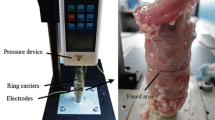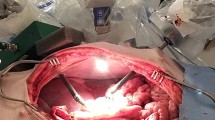Abstract
Background
Radiofrequency-controlled tissue fusion is a novel technology but the associated lateral thermal damage has not been determined.
Methods
Lateral thermal spread of in vivo and ex vivo bowel in a live porcine model fused by radiofrequency energy was evaluated using dynamic infrared thermography and histology.
Results
Mean maximum thermal spread measured on histology was <1.2 mm, with no significant difference between thermal spreads for in vivo and ex vivo bowel for radiofrequency energy delivered at 50 V (p = 0.98) and 100 V (p = 0.85). Mean total maximum thermal spread measured by dynamic infrared thermography was <3.9 mm wide on both sides of the instrument with no significant difference between thermal spreads for in vivo and ex vivo bowel for radiofrequency energy delivered at 50 V (p = 0.34) and 100 V (p = 0.19). Fusion quality for in vivo tissue was better when radiofrequency energy was delivered at 100 V compared with 50 V. However, thermal spread measurements and maximum temperatures reached in the tissue were similar in well- and poorly fused bowel. Thermal changes in well-fused bowel were more uniform throughout the different bowel wall layers, whereas in poorly fused tissues, the mucosa did not show thermally induced changes. There were no significant differences between the maximum temperatures detected for in vivo and ex vivo bowel for radiofrequency energy delivered at 50 V (p = 0.25) and 100 V (p = 0.14).
Conclusions
The total thermal changes at both sides of fused bowel are <3.9 mm. The heat sink effect of the application instrument overshadowed any effects of perfusion on limiting thermal spread. Also, using greater amounts of radiofrequency energy at 100 V to achieve better quality fusion does not necessarily increase lateral thermal damage compared with 50 V.






Similar content being viewed by others
References
Shields CA, Schechter DA, Tetzlaff P, Baily AL, Dycus S, Cosgriff N (2004) Method for creating ideal tissue fusion in soft-tissue structures using radio frequency (RF) energy. Surg Technol Int 13:49–55
Androsov PI (1970) Experience in the application of the instrumental mechanical suture in surgery of the stomach and rectum. Acta Chir Scand 136:57–63
Lim CBB, Goldin RD, Darzi A, Hanna GB (2008) Characterization of materials eliciting foreign body reaction in stapled human gastrointestinal anastomoses. Br J Surg 95:1044–1050
Ballantyne GH (1984) The experimental basis of intestinal suturing. Effect of surgical technique, inflammation, and infection on enteric wound healing. Dis Colon Rectum 27:61–71
Cilesiz I, Thomsen S, Welch AJ (1997) Controlled temperature tissue fusion: argon laser welding of rat intestine in vivo. Part one. Lasers Surg Med 21:269–277
Fenner JW, Martin W, Moseley H, Wheatley DJ (1994) Dehydration: a model for (low-temperature) argon laser tissue bonding. Phys Med Biol 39:2147–2160
Schned AR, Wheeler KJ, Hodorowski CA, Heaney JA, Ernstoff MS, Amdur RJ, Harris RD (1996) Tissue-shrinkage correction factor in the calculation of prostate cancer volume. Am J Surg Pathol 20:1501–1506
Campbell PA, Cresswell AB, Frank TG, Cuschieri A (2003) Real-time thermography during energized vessel sealing and dissection. Surg Endosc 17:1640–1645
Kinoshita T, Kanehira E, Omura K, Kawakami K, Watanabe Y (1999) Experimental study on heat production by a 23.5-kHz ultrasonically activated device for endoscopic surgery. Surg Endosc 13:621–625
ThermaCam Researcher Version 2.8 SR-1 user’s manual (2004). FLIR Systems
Jones BF (1998) A reappraisal of the use of infrared thermal image analysis in medicine. IEEE Trans Med Imaging 17:1019–1026
Reidenbach HD, Buess G (1992) Ancillary technology: electrocautery, thermoregulation and laser. In: Cuschieri A, Buess G, Perrisat L (eds) Operative manual of endoscopic surgery. Springer, Berlin, pp 44–60
Boylan A, Martin CJ, Gardner GG (1992) Infrared emissivity of burn wounds. Clin Phys Physiol Meas 13:125–127
Acknowledgment
The authors thank Tyco Healthcare for funding this study. Tyco Healthcare had no involvement in (1) the study design, (2) the data collection, analysis, or interpretation, (3) the writing of the report, or (4) the decision to submit the paper for publication.
Disclosures
Dr. Chern Beverly Lim, Dr. Robert Goldin, Dr. Daniel Elson, Professor Lord Ara Darzi, and Professor George Hanna have no conflicts of interest or financial ties to disclose.
Author information
Authors and Affiliations
Corresponding author
Rights and permissions
About this article
Cite this article
Lim, C.B.B., Goldin, R.D., Elson, D.S. et al. In vivo thermography during small bowel fusion using radiofrequency energy. Surg Endosc 24, 2465–2474 (2010). https://doi.org/10.1007/s00464-010-0987-0
Received:
Accepted:
Published:
Issue Date:
DOI: https://doi.org/10.1007/s00464-010-0987-0




